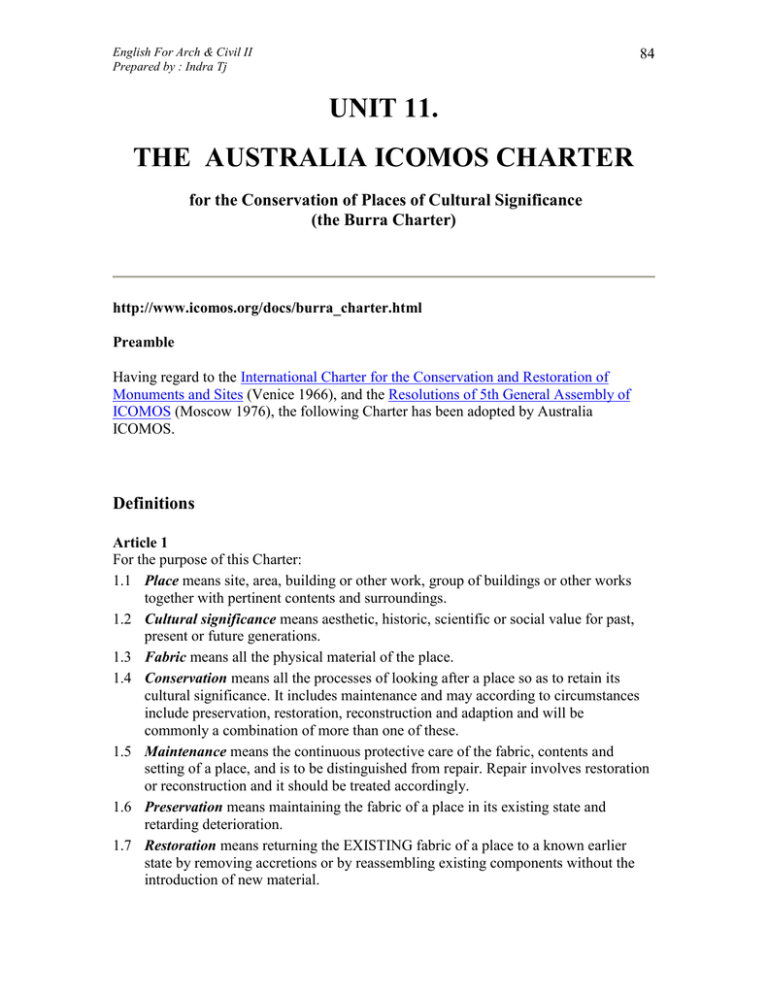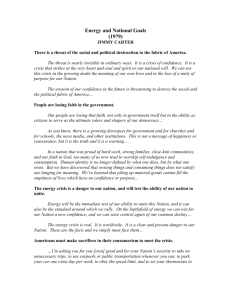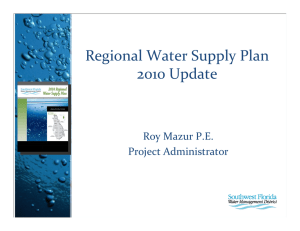UNIT 11. THE AUSTRALIA ICOMOS CHARTER (the Burra Charter)
advertisement

English For Arch & Civil II Prepared by : Indra Tj 84 UNIT 11. THE AUSTRALIA ICOMOS CHARTER for the Conservation of Places of Cultural Significance (the Burra Charter) http://www.icomos.org/docs/burra_charter.html Preamble Having regard to the International Charter for the Conservation and Restoration of Monuments and Sites (Venice 1966), and the Resolutions of 5th General Assembly of ICOMOS (Moscow 1976), the following Charter has been adopted by Australia ICOMOS. Definitions Article 1 For the purpose of this Charter: 1.1 Place means site, area, building or other work, group of buildings or other works together with pertinent contents and surroundings. 1.2 Cultural significance means aesthetic, historic, scientific or social value for past, present or future generations. 1.3 Fabric means all the physical material of the place. 1.4 Conservation means all the processes of looking after a place so as to retain its cultural significance. It includes maintenance and may according to circumstances include preservation, restoration, reconstruction and adaption and will be commonly a combination of more than one of these. 1.5 Maintenance means the continuous protective care of the fabric, contents and setting of a place, and is to be distinguished from repair. Repair involves restoration or reconstruction and it should be treated accordingly. 1.6 Preservation means maintaining the fabric of a place in its existing state and retarding deterioration. 1.7 Restoration means returning the EXISTING fabric of a place to a known earlier state by removing accretions or by reassembling existing components without the introduction of new material. English For Arch & Civil II Prepared by : Indra Tj 85 1.8 Reconstruction means returning a place as nearly as possible to a known state and is distinguished by the introduction of materials (new or old) into the fabric. This is not to be confused with either recreation or conjectural reconstruction which are outside the scope of this Charter. 1.9 Adaption means modifying a place to suit proposed compatible uses. 1.10 Compatible use means a use which involves no change to the culturally significant fabric, changes which are substantially reversible, or changes which require a minimal impact. Conservation principles Article 2 The aim of conservation is to retain or recover the cultural significance of a place and must include provision for its security, its maintenance and its future. Article 3 Conservation is based on a respect for the existing fabric and should involve the least possible physical intervention. It should not distort the evidence provided by the fabric. Article 4 Conservation should make use of all the disciplines which can contribute to the study and safeguarding of a place. Techniques employed should be traditional but in some circumstances they may be modern ones for which a firm scientific basis exists and which have been supported by a body of experience. Article 5 Conservation of a place should take into consideration all aspects of its cultural significance without unwarranted emphasis on any one at the expense of others. Article 6 The conservation policy appropriate to a place must first be determined by an understanding of its cultural significance and its physical condition. Article 7 The conservation policy will determine which uses are compatible. Article 8 Conservation requires the maintenance of an appropriate visual setting, e.g. form, scale, colour, texture and materials. No new construction, demolition or modification which would adversely affect the settings which adversely affect appreciation or enjoyment of the place should be excluded. English For Arch & Civil II Prepared by : Indra Tj 86 Article 9 A building or work should remain in its historical location. The moving of all or part of a building or work is unacceptable unless this is the sole means of ensuring its survival. Article 10 The removal of contents which form part of the cultural significance of the place is unacceptable unless it is the sole means of ensuring their security and preservation. Such contents must be returned should changed circumstances make this practicable. Conservation processes PRESERVATION Article 11 Preservation is appropriate where the existing state of the fabric itself constitutes evidence of specific cultural significance, or where insufficient evidence is available to allow other conservation processes to be carried out. Article 12 Preservation is limited to the protection, maintenance and where necessary, the stabilisation of the existing fabric but without the distortion of its cultural significance. RESTORATION Article 13 Restoration is appropriate only if there is sufficient evidence of an earlier state of the fabric and only if returning the fabric to that state recovers the cultural significance of the place. Article 14 Restoration should reveal anew culturally significant aspects of the place. It is based on respect for all the physical, documentary and other evidence and stops at the point where conjecture begins. English For Arch & Civil II Prepared by : Indra Tj 87 Article 15 Restoration is limited to the reassembling of displaced components or removal of accretions in accordance with Article 16. Article 16 The contributions of all periods to the place must be respected. If a place includes the fabric of different periods, revealing the fabric of one period at the expense of another can only be justified when what is removed is of slight cultural significance and the fabric which is to be revealed is of much greater cultural significance. RECONSTRUCTION Article 17 Reconstruction is appropriate where a place is incomplete through damage or alteration and where it is necessary for its survival, or where it recovers the cultural significance of the place as a whole. Article 18 Reconstruction is limited to the completion of a depleted entity and should not constitute the majority of the fabric of a place. Article 19 Reconstruction is limited to the reproduction of fabric, the form of which is known from physical and/or documentary evidence. It should be identifiable on close inspection as being new work. ADAPTION Article 20 Adaption is acceptable where the conservation of the place cannot otherwise be achieved, and where the adaption does not substantially detract from its cultural significance. Article 21 Adaption must be limited to that which is essential to a use for the place, determined in accordance with Articles 6 and 7. Article 22 Fabric of cultural significance unavoidably removed in the process of adaption must be kept safely to enable its future reinstatement. English For Arch & Civil II Prepared by : Indra Tj 88 Conservation practice Article 23 Work on a place must be preceded by professionally prepared studies of the physical, documentary and other evidence, and the existing fabric recorded before any disturbance of the place. Article 24 Study of a place by any disturbance of the fabric or by archaeological excavation should be undertaken where necessary to provide data essential for decisions on the conservation of the place and/or to secure evidence about to be lost or made inaccessible through necessary conservation or other unavoidable action. Investigation of a place for any other reason which requires physical disturbance and which adds substantially to a scientific body of knowledge may be permitted, provided that it is consistent with the conservation policy for the place. Article 25 A written statement of conservation policy must be professionally prepared setting out the cultural significance, physical condition and proposed conservation process together with justification and supporting evidence, including photographs, drawings and all appropriate samples. Article 26 The organisation and individuals responsible for policy decisions must be named and specific responsibility taken for each such decision. Article 27 Appropriate professional direction and supervision must be maintained at all stages of the work and a log kept of new evidence and additional decisions recorded as in Article 25 above. Article 28 The records required by Articles 23, 25, 26 and 27 should be placed in a permanent archive and made publicly available. Article 29 The items referred to in Article 10 and Article 22 should be professionally catalogued and protected. COPY FROM : http://www.unescobkk.org/culture/australia_icomos.htm English For Arch & Civil II Prepared by : Indra Tj 89 THE AUSTRALIA ICOMOS CHARTER A. SKIMMING, READING & UNDERSTANDING Please read carefully the ICOMOS CHARTER, and try to understand the whole idea behind this charter. B. DISCUSSION GROUP The class should be divided into some group. Each group has to discuss different topic from the ICOMOS CHARTER : Definitions Conservation principles Conservation process Restoration Reconstruction Adaptation Conservation practice C. FINDING MORE INFORMATION The students have to do some assignment for finding other charter ( from different country ) that related to ICOMOS or Heritage Conservation. D. OTHER ASSIGNMENT Find some places in Indonesia that should be conserving. The student might discuss the technology that had been use in the past.





